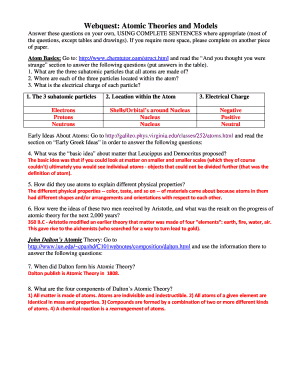
Get Webquest: Atomic Theories And Models
How it works
-
Open form follow the instructions
-
Easily sign the form with your finger
-
Send filled & signed form or save
How to fill out the Webquest: Atomic Theories and Models online
This guide provides clear instructions on how to effectively complete the Webquest: Atomic Theories and Models form online. By following these steps, users will gain a comprehensive understanding of atomic theories and models while ensuring their work is properly submitted.
Follow the steps to successfully complete the Webquest: Atomic Theories and Models.
- Press the 'Get Form' button to access the Webquest: Atomic Theories and Models form and open it in your preferred online editor.
- Begin with the 'Atom Basics' section. Navigate to the provided link and read the section titled 'And you thought you were strange' to answer the three questions in the table. Make sure to fill in the names, locations, and charges of the three subatomic particles: electrons, protons, and neutrons.
- Proceed to the 'Early Ideas About Atoms' section. Visit the given link to learn about the concepts proposed by Leucippus and Democritus. Answer the questions regarding their basic ideas and their reception by Aristotle.
- In the 'John Dalton’s Atomic Theory' section, find the necessary information at the provided link. Record Dalton's publication year and the four key components of his atomic theory.
- Next, in 'J.J. Thomson and the Electron', use the link to gather details about Thomson's discovery of the electron in 1897, the evidence for smaller particles, and his model of the atom proposed in 1904.
- For the 'Rutherford and Bohr Break the “Plum Pudding” Model' section, visit the link to summarize the key components of the plum pudding model and how it was modified by Bohr. Record the size of the nucleus compared to the atom and Bohr's revolutionary ideas.
- Move to the 'Chadwick (and Rutherford) and the Neutron' section. Refer to the specified link to discover what constitutes atomic number and mass, and what led to the conclusion that neutrons exist.
- Finally, complete the 'History of the Atom Timeline' section by clicking the designated link. Fill in the timeline with observations, dates, and respective inventors based on provided clues.
- Once all sections are filled out, review your form for accuracy and completeness. Users can then save their changes, download, print, or share the completed form as needed.
Complete your Webquest: Atomic Theories and Models online today!
Dalton developed his atomic theory between 1803 and 1808, culminating in its publication in his work, 'A New System of Chemical Philosophy.' This theory proposed that all matter consists of indivisible atoms and that atoms of a given element are identical in mass and properties. His ideas not only revolutionized chemistry but also influenced future scientific inquiry. Gain further insights by exploring our Webquest: Atomic Theories and Models.
Industry-leading security and compliance
-
In businnes since 199725+ years providing professional legal documents.
-
Accredited businessGuarantees that a business meets BBB accreditation standards in the US and Canada.
-
Secured by BraintreeValidated Level 1 PCI DSS compliant payment gateway that accepts most major credit and debit card brands from across the globe.


